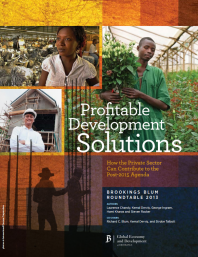
Profitable Development Solutions: How the Private Sector Can Contribute to the Post-2015 Agenda

Introduction (excerpt)
Deliberations around the expiration of the Millennium Development Goals and what comes after them are infused with optimism that the end of extreme poverty is within the world’s grasp.
When United Nations secretary-general Ban Ki-moon convened a high-level panel to forge a new global post-2015 Development Agenda, the centerpiece of the group’s final report called for “eradicating extreme poverty from the face of the earth by 2030.” The prospects for achieving this goal do not seem so far-fetched; half a billion people have been lifted out of extreme poverty (those living under $1.25 per day) since 2000 alone. However, further progress will require broad-based and sustainable economic growth across the developing world, innovative and affordable ways to deliver basic needs for the poor as well as major new investments to tackle global challenges such as climate change. Addressing these issues will require an all-hands-on-deck approach from all the players involved in international development. Notably, the private sector—from small and medium-sized enterprises to major global corporations— must play an expanded role if this vision is to be realized.
- Issue:
- Economics
- Region:
- Global
- Year Published:
- 2014
- Authors:
- Homi Kharas, Laurence Chandy, Steven Rocker, George Ingram, Kemal Derviş
- Institution:
- Brookings Institution

